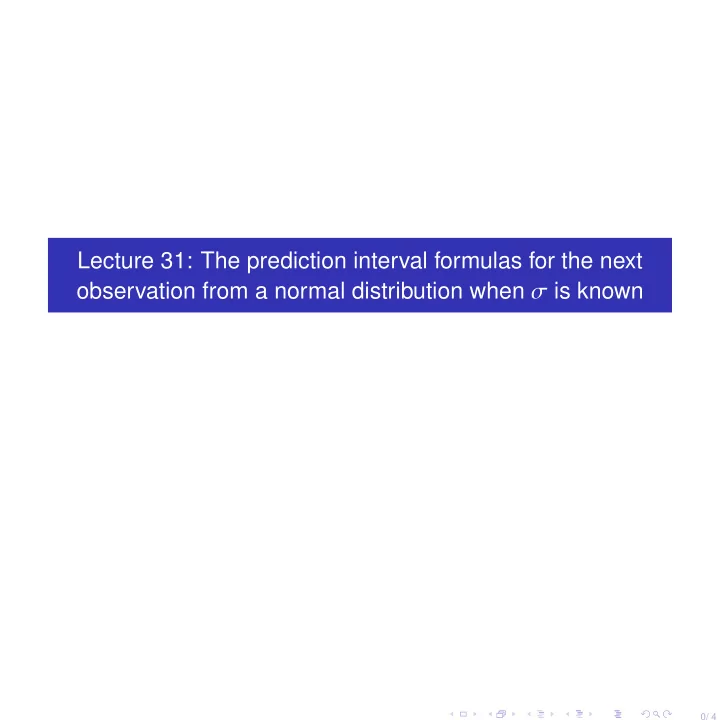

Lecture 31: The prediction interval formulas for the next observation from a normal distribution when σ is known 0/ 4
1. Introduction In this lecture we will derive the formulas for the symmetric two-sided prediction interval for the n + 1 − -st observation and the upper-tailed prediction interval for the n + 1-st observation from a normal distribution when the variance σ 2 is known . We will need the following theorem from probability theory that gives the distribution of the statistic X − X n + 1 . Suppose that X 1 , X 2 , . . . , X n , X n + 1 is a random sample from a normal distribution with mean µ and variance σ 2 . We assume µ is unknown but σ 2 is known. Theorem 1 The random variable X − X n − 1 has normal distribution with mean zero and variance n + 1 σ 2 . Hence we find that the random variable n � n + 1 � � Z = X − X n + 1 / σ has standard normal distribution. n 2. The two-sided prediction interval formula Now we can prove the theorem from statistics giving the required prediction interval for the next observation x n + 1 in terms of n observations x 1 , x 2 , . . . , x n . Note that it is symmetric around X . This is one of the basic theorems that you have to learn how to prove. There are also asymmetric two-sided prediction intervals. 1/ 4 Lecture 31: The prediction interval formulas for the next observation from a normal distribution when σ is known
Theorem 2 � � � � n + 1 n + 1 n σ, X + z α / The random interval X − z α / n σ is a 2 2 100 ( 1 − α )% -prediction interval for x n + 1 . Proof. We are required to prove � � n + 1 n + 1 σ, x + x α / = 1 − α. P X n + 1 ∈ X − z α / σ 2 2 n n We have � n + 1 √ LHS = P X − z α / σ < X n + 1 , X n + 1 < X + z α / n + 1 n σ 2 2 n � n + 1 = P X − X n + 1 < z α / σ 2 n � � n + 1 n + 1 = P X − X n + 1 < z α / σ, X − X n + 1 > − z α / σ 2 2 n n = P ( Z < z α / 2 , Z > z α / 2 ) = P ( − z α / 2 < Z < z α / 2 ) = 1 − α To prove the last equality draw a picture. � 2/ 4 Lecture 31: The prediction interval formulas for the next observation from a normal distribution when σ is known
Once we have an actual sample x 1 , x 2 , . . . , x n we obtain the observed value � � n + 1 n + 1 x − z α / σ, x − z α / σ for the prediction (random) interval 2 2 n n � n + 1 � n + 1 σ, X + z α / X − z α / n σ The observed value of the prediction 2 2 n (random) interval is also called the two-sided 100 ( 1 − α )% prediction interval for x n + 1 . 3. The upper-tailed prediction interval In this section we will give the formula for the upper-tailed prediction interval for the next observation x n + 1 . Theorem 3 √ � � The random interval X − z α n + 1 n σ, ∞ is a 100 ( 1 − α )% -prediction interval for the next observation x n + 1 . Proof We are required to prove � n + 1 P ( X n + 1 ∈ ( X − z α σ, ∞ )) = 1 − α. n 3/ 4 Lecture 31: The prediction interval formulas for the next observation from a normal distribution when σ is known
Proof (Cont.) We have � n + 1 LHS = P X − z α σ < X n + 1 n To prove the last equality draw a picture - I want you to draw the picture on tests and the final. � Once we have an actual sample x 1 , x 2 , . . . , x n we obtain the observed value � n + 1 x − z α of the upper-tailed prediction (random) interval σ, ∞ n � � � n + 1 X − z α n σ, ∞ The observed value of the upper-tailed prediction (random) interval is also called the upper-tailed 100 ( 1 − α )% prediction interval for x n + 1 . � n + 1 The number random variable X − z α σ or its observed value n � n + 1 x − z α σ is often called a prediction lower bound for x n + 1 because n � n + 1 = 1 − α. P X − z α σ < X n + 1 n 4/ 4 Lecture 31: The prediction interval formulas for the next observation from a normal distribution when σ is known
Recommend
More recommend